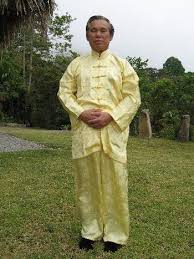STANDING MEDITATION, SITTING MEDITATION, MOVING MEDITATION AND MERGING WITH THE COSMOS

In the Small Universe, chi flows down the body from the lips to the hui-yin vital point, then up the spine and round the head to the lips in a continuous flow
Question
Having successfully Merged with the Cosmos using Sitting Meditation, that person can subsequently also Merge with the Cosmos through Standing Meditation ... and perhaps even through Moving Meditation (eg performing Taijiquan in Perfect 6 Harmonies ) .... and by extrapolation, even while going about mundane everyday life (i.e. Absolute Zen in Daily Living )? On the other hand, a novice having trouble relaxing even in Standing Meditation would be able to relax better by Moving Meditation?
Personal experience found that in Standing Meditation the chi tends to roll down to the lower dantian (2-3 inches below navel ) and while in Sitting Meditation the chi tends to rise up the back (and hold up the spine without effort ) to settle at the upper dantian (above and between eyebrows). Are these chi directional flow natural or artificially induced due to mental focus at appropriate dantians depending on the 3 general aims of meditation (i.e. Relaxation, Peak Performance, Merging with Cosmos)? Additionally, using our chi kung phrase "flowingly still", Sitting Meditation is more "still" compared to Standing Meditation and hence the chi is more "locked-in" to enhance mental focus and meditation depth?
Dr Damian Kissey
Answer
In theory what you say is true. Having merged with the Cosmos using sitting meditation (in a lotus or semi-lotus position), that person can merge with the Cosmos in standing meditation or moving meditation, like performing Taijiquan in perfect six harmonies. He can also merge with the Cosmos while going about in mundane everyday life.
In fact, a person can merge with the Cosmos not necessarily practicing sitting meditation. Once he can stop thoughts occurring, he, or any being, merges with the Cosmos.
But in practice, sitting meditation in a lotus or semi-lotus position is the paramount way to merge with the Cosmos. In other words, even when a person merged with the Cosmos before, and returned to the phenomenal world, he has to perform sitting meditation in a lotus or semi-lotus position to merge with the Cosmos again.
There are exceptions. As I have mentioned in one of our answers, we are elite in that we can merge with the Cosmos using standing meditation.
It is worthwhile to mention that the term “Cosmos” here means the Great Void, like in Zhang San Feng’s Treatise where Taiji, or the Cosmos, originates from Wuji, or the Great Void, and returns to Wuji. Sometimes we use the term “Cosmos” to mean the phenomenal realm.
Whether a novice having trouble relaxing in standing meditation could relax better in moving meditation, would depend on a few factors, like whether he has a good teacher and whether he is tensed or he can free his mind of thoughts.
If I have to compare standing meditation and moving meditation, I would think he can relax better in standing meditation. In moving meditation, he has to move his hands, legs or body, which may distract him from being relaxed.
In your case when you perform standing meditation chi rolls down to your abdominal dan tian, and when you perform sitting meditation chi rises up your spine, because you are advanced in both standing meditation and sitting meditation.
By the way, some masters refer to the dan tian 2-3 inches below the navel as the lower dan tian, and others as the middle dan tian. There are no hard and fast rules.
Most other people will be stressed by myriad thoughts as well as be tensed in both standing and sitting meditation. Comparing the two forms of meditation, most people will be more stressed and more tensed in sitting meditation.
If we take the four forms of meditation -- standing, sitting, lying down and moving -- the ascending order is as follows, with the first form of meditation being the least stressful and tensed:
Lying down -- standing -- moving -- sitting
To be relaxed and to free the mind of all thoughts are necessary condition for meditation, which actually means training the mind or spirit. Interestingly they are also the first benefits.
Although lying down meditation is easier to be relaxed and freeing the mind of all thoughts, standing meditation is usually recommended for beginners, because many people tend to sleep instead of training their spirit.
From my perspective, not many people, including those who have spent much time in meditation retreats, know that meditation is training of mind or spirit. They relate meditation to sitting crossed legged or in a lotus position.
The directional flow of chi down to the dan tian or up along the spine is induced by mental focus or other methods. In my case I was able to speed up tremendously to let chi flow up my spine from the hui-yin vital point at the anus to the bai-hui vital point at the crown of the head, and later to the tian-mu vital point between the eyebrows, because of reverse breathing, which is different from chest breathing.
The three aims of meditation, which correspond to relaxation as the basic aim, peak performance as the intermediate aim, and merging with the Cosmos as the highest aim, depend on how long and how successfully a practitioner trains in meditation, and not on the directional flow of chi or on any methods.
If all other things were equal, sitting meditation is more still than standing meditation. Chi is more “locked-in” or “consolidated” to enhance mental focus and meditation depth.

Meditation is not just sitting cross-legged or in a lotus position; it is a training of mind or spirit. Here Grandmaster Wong in in moving meditation.
The questions and answers are reproduced from the thread Questions on Wuji Stance or Standing Meditation in the Shaolin Wahnam Discussion Forum.
LINKS
